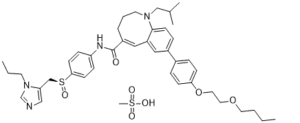Cenicriviroc Mesylate
This product is for research use only, not for human use. We do not sell to patients.

For small sizes, please check our retail website as below: www.invivochem.com
| Size | Price | Stock |
|---|---|---|
| 250mg | $1650 | Check With Us |
| 500mg | $2450 | Check With Us |
| 1g | $3675 | Check With Us |
Cat #: V3747 CAS #: 497223-28-6 Purity ≥ 98%
Description: Cenicriviroc Mesylate (formerly known as TAK-652 Mesylate or TBR-652 Mesylate) is a novel, orally bioactive, and dual antagonist of CCR2/CCR5, it also inhibits both HIV-1 and HIV-2, and has the potential for the treatment of HIV infection.
Top Publications Citing Invivochem Products
Publications Citing InvivoChem Products
Product Promise

- Physicochemical and Storage Information
- Protocol
- Related Biological Data
- Stock Solution Preparation
- Quality Control Documentation
| Molecular Weight (MW) | 793.05 |
|---|---|
| Molecular Formula | C42H56N4O7S2 |
| CAS No. | 497223-28-6 |
| Storage | -20℃ for 3 years in powder formr |
| -80℃ for 2 years in solvent | |
| Solubility In Vitro | DMSO: > 100 mg/mLr |
| Water: N/Ar | |
| Ethanol: N/A | |
| Synonyms | TBR-652 mesylate; TBR 652 mesylate; TAK-652 mesylate; TAK652 mesylate; TAK 652; TBR652; Cenicriviroc mesylate |
| Protocol | In Vitro | Migration of mouse monocytes in response to carbon tetrachloride (CCL2) is reduced following pre-treatment with Cenicriviroc Mesylate (CVC) at a concentration of 1 μM. Compare to untreated and unstimulated cells, the average fold change in migrating cells (±SD) is 0.8±0.2 (p>0.05) and 0.7±0.4 (p>0.05) for CCL2-stimulated cells treated with Cenicriviroc Mesylate and unstimulated cells treated with Cenicriviroc Mesylate, respectively |
|---|---|---|
| In Vivo | Cenicriviroc Mesylate (CVC) treatment leads to dose-related decrease in monocyte/macrophage recruitment, and achieving statistical significance at doses ≥20 mg/kg/day (p<0.05). Compare to the vehicle-control group, peritoneal lavage monocyte/macrophage counts are decreased by: 5.7%, 45.2%, 76.5% and 26.0% for Cenicriviroc Mesylate 5 twice daily (BID), Cenicriviroc Mesylate20 twice daily (BID), Cenicriviroc Mesylate100 BID, Cenicriviroc Mesylate 20 once-daily (QD), respectively. Exposure to Cenicriviroc Mesylate is dose-related and correlated with the decrease in monocyte/macrophage recruitment, with Cenicriviroc Mesylate appearing to be more effective when given BID versus QD, in line with the higher plasma concentrations achieved with BID dosing and the known short half-life in mice (~2 hours) |
These protocols are for reference only. InvivoChem does not
independently validate these methods.
| Solvent volume to be added | Mass (the weight of a compound) | |||
|---|---|---|---|---|
| Mother liquor concentration | 1mg | 5mg | 10mg | 20mg |
| 1mM | 1.2610 mL | 6.3048 mL | 12.6095 mL | 25.2191 mL |
| 5mM | 0.2522 mL | 1.2610 mL | 2.5219 mL | 5.0438 mL |
| 10mM | 0.1261 mL | 0.6305 mL | 1.2610 mL | 2.5219 mL |
| 20mM | 0.0630 mL | 0.3152 mL | 0.6305 mL | 1.2610 mL |
The molarity calculator equation
Mass(g) = Concentration(mol/L) × Volume(L) × Molecular Weight(g/mol)
Mass
=
Concentration
×
Volume
×
Molecular Weight*
The dilution calculator equation
Concentration(start)
×
Volume(start)
=
Concentration(final)
×
Volume(final)
This equation is commonly abbreviated as: C1 V1 = C2 V2
Concentration(start)
C1
×
Volume(start)
V1
=
Concentration(final)
C2
×
Volume(final)
V2
Step One: Enter information below
Dosage mg/kg
Average weight of animals g
Dosing volume per animal µL
Number of animals
Step Two: Enter the in vivo formulation
%DMSO
+
%
+
%Tween 80
+
%ddH2O
Calculation Results:
Working concentration:
mg/ml;
Method for preparing DMSO master liquid:
mg
drug pre-dissolved in
µL
DMSO(Master liquid concentration
mg/mL)
,Please contact us first if the concentration exceeds the DMSO solubility of the batch of drug.
Method for preparing in vivo formulation:
Take
µL
DMSO master liquid, next add
µL
PEG300, mix and clarify, next add
µL
Tween 80,mix and clarify, next add
µL
ddH2O,mix and clarify.
Note:
- (1) Please be sure that the solution is clear before the addition of next solvent. Dissolution methods like vortex, ultrasound or warming and heat may be used to aid dissolving.
- (2) Be sure to add the solvent(s) in order.




































